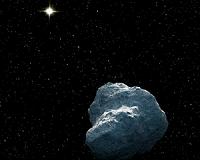 |
Boston MA (SPX) Oct 08, 2010 If you think global warming is bad, 11 billion years ago the entire universe underwent, well, universal warming. The consequence was that fierce blasts of radiation from voracious black holes stunted the growth of some small galaxies for a stretch of 500 million years. This is the conclusion of a team of astronomers who used the new capabilities of NASA's Hubble Space Telescope to probe the invisible, remote universe. Using the newly installed Cosmic Origins Spectrograph (COS) they have identified an era, from 11.7 to 11.3 billion years ago, when the universe stripped electrons off from primeval helium atoms - a process called ionization. This process heated intergalactic gas and inhibited it from gravitationally collapsing to form new generations of stars in some small galaxies. The lowest-mass galaxies were not even able to hold onto their gas, and it escaped back into intergalactic space. Michael Shull of the University of Colorado and his team were able to find the telltale helium spectral absorption lines in the ultraviolet light from a quasar - the brilliant core of an active galaxy. The quasar beacon shines light through intervening clouds of otherwise invisible gas, like a headlight shining through a fog. The beam allows for a core-sample probe of the clouds of gas interspersed between galaxies in the early universe. The universe went through an initial heat wave over 13 billion years ago when energy from early massive stars ionized cold interstellar hydrogen from the big bang. This epoch is actually called reionization because the hydrogen nuclei were originally in an ionized state shortly after the big bang. But Hubble found that it would take another 2 billion years before the universe produced sources of ultraviolet radiation with enough energy to do the heavy lifting and reionize the primordial helium that was also cooked up in the big bang. This radiation didn't come from stars, but rather from quasars. In fact the epoch when the helium was being reionized corresponds to a transitory time in the universe's history when quasars were most abundant. The universe was a rambunctious place back then. Galaxies frequently collided, and this engorged supermassive black holes in the cores of galaxies with infalling gas. The black holes furiously converted some of the gravitational energy of this mass to powerful far-ultraviolet radiation that would blaze out of galaxies. This heated the intergalactic helium from 18,000 degrees Fahrenheit to nearly 40,000 degrees. After the helium was reionized in the universe, intergalactic gas again cooled down and dwarf galaxies could resume normal assembly. "I imagine quite a few more dwarf galaxies may have formed if helium reionization had not taken place," said Shull. So far Shull and his team only have one sightline to measure the helium transition, but the COS science team plans to use Hubble to look in other directions to see if the helium reionization uniformly took place across the universe.
Share This Article With Planet Earth
Related Links Hubble Space Telescope Space Telescope News and Technology at Skynightly.com
 NASA's Hubble Harvests Distant Solar System Objects
NASA's Hubble Harvests Distant Solar System ObjectsCambridge MA (SPX) Sep 14, 2010 Beyond the orbit of Neptune reside countless icy rocks known as trans-Neptunian objects (TNOs). One of the biggest, Pluto, is classified as a dwarf planet. The region also supplies us with comets such as famous Comet Halley. Most TNOs are small and receive little sunlight, making them faint and difficult to spot. Now, astronomers using clever techniques to cull the data archives of NASA's ... read more |
|
| The content herein, unless otherwise known to be public domain, are Copyright 1995-2010 - SpaceDaily. AFP and UPI Wire Stories are copyright Agence France-Presse and United Press International. ESA Portal Reports are copyright European Space Agency. All NASA sourced material is public domain. Additional copyrights may apply in whole or part to other bona fide parties. Advertising does not imply endorsement,agreement or approval of any opinions, statements or information provided by SpaceDaily on any Web page published or hosted by SpaceDaily. Privacy Statement |